The International Conference on Intelligent Computing (ICIC) was formed to provide an annual forum dedicated to the emerging and challenging topics in artificial intelligence, machine learning, bioinformatics, and computational biology, etc. It aims to bring - gether researchers and practitioners from both academia and industry to share ideas, problems, and solutions related to the multifaceted aspects of intelligent computing. ICIC 2009, held in Ulsan, Korea, September 16–19, 2009, constituted the 5th - ternational Conference on Intelligent Computing. It built upon the success of ICIC 2008, ICIC 2007, ICIC 2006, and ICIC 2005 held in Shanghai, Qingdao, Kunming, and Hefei, China, 2008, 2007, 2006, and 2005, respectively. This year, the conference concentrated mainly on the theories and methodologies as well as the emerging applications of intelligent computing. Its aim was to unify the p- ture of contemporary intelligent computing techniques as an integral concept that hi- lights the trends in advanced computational intelligence and bridges theoretical research with applications. Therefore, the theme for this conference was “Emerging Intelligent Computing Technology and Applications.” Papers focusing on this theme were solicited, addressing theories, methodologies, and applications in science and technology.
